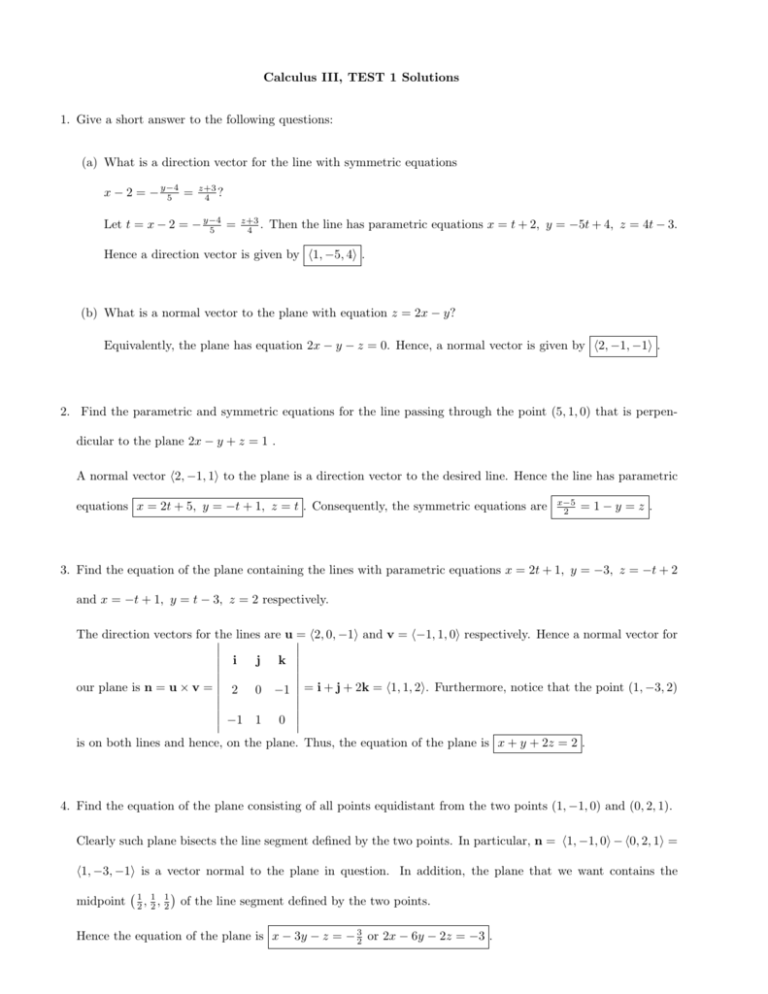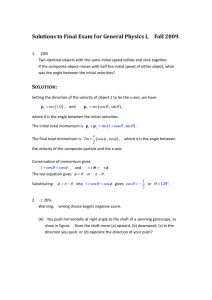Calculus III, TEST 1 Solutions 1. Give a short
advertisement

Calculus III, TEST 1 Solutions 1. Give a short answer to the following questions: (a) What is a direction vector for the line with symmetric equations x − 2 = − y−4 5 = z+3 4 ? Let t = x − 2 = − y−4 5 = z+3 4 . Then the line has parametric equations x = t + 2, y = −5t + 4, z = 4t − 3. Hence a direction vector is given by h1, −5, 4i . (b) What is a normal vector to the plane with equation z = 2x − y? Equivalently, the plane has equation 2x − y − z = 0. Hence, a normal vector is given by h2, −1, −1i . 2. Find the parametric and symmetric equations for the line passing through the point (5, 1, 0) that is perpendicular to the plane 2x − y + z = 1 . A normal vector h2, −1, 1i to the plane is a direction vector to the desired line. Hence the line has parametric equations x = 2t + 5, y = −t + 1, z = t . Consequently, the symmetric equations are x−5 2 =1−y =z . 3. Find the equation of the plane containing the lines with parametric equations x = 2t + 1, y = −3, z = −t + 2 and x = −t + 1, y = t − 3, z = 2 respectively. The direction vectors for the lines are u = h2, 0, −1i and v = h−1, 1, 0i respectively. Hence a normal vector for i j k our plane is n = u × v = 2 0 −1 = i + j + 2k = h1, 1, 2i. Furthermore, notice that the point (1, −3, 2) −1 1 0 is on both lines and hence, on the plane. Thus, the equation of the plane is x + y + 2z = 2 . 4. Find the equation of the plane consisting of all points equidistant from the two points (1, −1, 0) and (0, 2, 1). Clearly such plane bisects the line segment defined by the two points. In particular, n = h1, −1, 0i − h0, 2, 1i = h1, −3, −1i is a vector normal to the plane in question. In addition, the plane that we want contains the midpoint 1 1 1 2, 2, 2 of the line segment defined by the two points. Hence the equation of the plane is x − 3y − z = − 32 or 2x − 6y − 2z = −3 . 5. Let r(t) =< et , et cos t, et sin t >. (a) Find r0 (t). r0 (t) =< d t d t dt e , dt e d t cos t, dt e sin t >=< et , et cos t−et sin t, et cos t+et sin t >= et h1, cos t − sin t, cos t + sin ti (b) Reparametrize r with respect to arclength. √ Rt √ √ Rt Rt q 2 2 s = 0 |r0 (u)| du = 0 eu 1 + (cos u − sin u) + (cos u + sin u) du = 3 0 eu du = et 3 − 3. Hence et = √ s+ √ 3 3 = √ s 3+3 3 Consequently, D √ r (s) = s 33+3 , and so t = ln s √ s 3+3 3 √ 3+3 . 3 √ cos ln s 33+3 , √ s 3+3 3 √ E sin ln s 33+3 = √ s 3+3 3 D √ √ E . 1, cos ln s 33+3 , sin ln s 33+3 (c) Find the unit tangent, unit normal and binormal vectors at the point (1, 1, 0). T= r0 (t) |r0 (t)| N= T0 (t) |T0 (t)| = = et 1 √ 3 et h1, cos t − sin t, cos t + sin ti = 1 √ h0, 3 1 √ 3 √ − sin t−cos t, − sin t+cos ti (− sin t−cos t)2 +(− sin t+cos t)2 The point (1, 1, 0) occurs Thus B = T × N = √16 = √1 2 √1 3 h1, cos t − sin t, cos t + sin ti, h0, − sin t − cos t, − sin t + cos ti. when t = 0. Hence T = √13 h1, 1, 1i and N = √12 h0, −1, 1i . i j k 1 1 1 1 1 = √6 (2i − j − k) and so B = √6 h2, −1, −1i . 0 −1 1 (d) Find the curvature, the normal plane and the osculating plane at the point (1, 1, 0). |T0 | The curvature is given by κ = The normal plane has T = |r0 | √1 3 The osculating plane has B = = √ √2 √3 3 √ = 2 3 . h1, 1, 1i as its normal vector and thus it is given by x + y + z = 2 . √1 6 h2, −1, −1i as its normal vector and thus it is given by 2x − y − z = 1 . 6. Identify the following surfaces (a) z = x2 + y 2 + 1 This is a circular paraboloid. (b) 4x2 + z = 100 This is a parabolic cylinder. 7. At what point on the curve r (t) = t3 , 3t, t4 is the normal plane parallel to the plane 6x + 6y − 8z = 1? Since r0 (t) gives a normal vector to the normal plane, we need to find the value(s) of t for which r0 (t) is parallel to the normal vector h6, 6, −8i of the plane 6x + 6y − 8z = 1. Hence we need 3t2 , 3, 4t3 to be parallel to h6, 6, −8i. In other words we need to find k and t, such that 3t2 = 6k, 3 = 6k, 4t3 = −8k. Solving the system we obtain k = 1 2 and t = −1. Therefore the point that we seek is r (−1) = (−1, −3, 1). 8. Show that if r is a vector function such that r00 exists, then d [r (t) × r0 (t)] = r (t) × r00 (t) . dt By the product rule, d dt [r (t) × r0 (t)] = r0 (t) × r0 (t) + r (t) × r00 (t). |r0 (t)| |r0 (t)| sin 0 = 0 and so r0 (t) × r0 (t) = 0. Hence d dt Now notice that |r0 (t) × r0 (t)| = [r (t) × r0 (t)] = r0 (t) × r0 (t) + r (t) × r00 (t) = 0 + r (t) × r00 (t) = r (t) × r00 (t) which is what we wanted to show.







